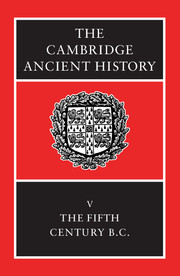Book contents
- Frontmatter
- Contents
- List of maps
- List of text-figures
- Preface
- 1 Sources, chronology, method
- 2 Greece after the Persian Wars
- 3 The Delian League to 449 b. c.
- 4 The Athenian revolution
- 5 Mainland Greece, 479–451 b. c.
- 6 The Thirty Years' Peace
- 7 Sicily, 478-431 b.c.
- 8 Greek culture, religion and society in the fifth century b.c.
- 8a Art: Archaic to Classical
- 8b Classical Cities and Sanctuaries
- 8c Rebuilding in Athens and Attica
- 8d Panhellenic Cults and Panhellenic Poets
- 8e Athenian Cults and Festivals
- 8f Athenian Religion and Literature
- 8g Society and Economy
- 8h Athens as a Cultural Centre
- 9 The Archidamian War
- 10 The Peace of Nicias and the Sicilian Expedition
- 11 The Spartan Resurgence
- Chronological Notes
- Chronological Table
- BIBLIOGRAPHY
- Index
- 1 Greece and Western Asia Minor
- References
8b - Classical Cities and Sanctuaries
from 8 - Greek culture, religion and society in the fifth century b.c.
Published online by Cambridge University Press: 28 March 2008
- Frontmatter
- Contents
- List of maps
- List of text-figures
- Preface
- 1 Sources, chronology, method
- 2 Greece after the Persian Wars
- 3 The Delian League to 449 b. c.
- 4 The Athenian revolution
- 5 Mainland Greece, 479–451 b. c.
- 6 The Thirty Years' Peace
- 7 Sicily, 478-431 b.c.
- 8 Greek culture, religion and society in the fifth century b.c.
- 8a Art: Archaic to Classical
- 8b Classical Cities and Sanctuaries
- 8c Rebuilding in Athens and Attica
- 8d Panhellenic Cults and Panhellenic Poets
- 8e Athenian Cults and Festivals
- 8f Athenian Religion and Literature
- 8g Society and Economy
- 8h Athens as a Cultural Centre
- 9 The Archidamian War
- 10 The Peace of Nicias and the Sicilian Expedition
- 11 The Spartan Resurgence
- Chronological Notes
- Chronological Table
- BIBLIOGRAPHY
- Index
- 1 Greece and Western Asia Minor
- References
Summary
The Greek city was a creation of the Archaic period, in architectural form as in political, religious and social life. The fifth century was a time of continued development and of refinement. This was still strongly concentrated in the temple, and in the Doric and Ionic orders. In other elements of the city there was a good deal of what one might call non-architecture. Many activities took place under the open sky on a piece of ground demarcated for the purpose. The city centre, the Agora, was a loose aggregation of mostly simple buildings around an open square. Buildings specifically designed were slow in making their appearance and attaining a complete form. The ubiquitous and adaptable stoa supplied the deficiency to some extent. Houses were unpretentious; and though the best of them were well built and commodious, their outward treatment gave no architectural distinction to the narrow streets. Next to the major temples, the city walls were the most impressive works of architecture.
Cities old and new were built on an endless variety of sites – around an acropolis or on one side, on a terraced slope, on a ridge or spur, headland or peninsula, on ground which rose theatre-like from a harbour, occasionally even on level or featureless ground; and the way in which the architectural elements were adapted to their setting varied enormously. Many old cities, especially in Greece proper, kept the irregular, loosely-knit form which they had attained by expansion, gradual or spasmodic, around acropolis, Agora or, on some sites, age-old shrines.
- Type
- Chapter
- Information
- The Cambridge Ancient History , pp. 184 - 205Publisher: Cambridge University PressPrint publication year: 1992
References
- 1
- Cited by

